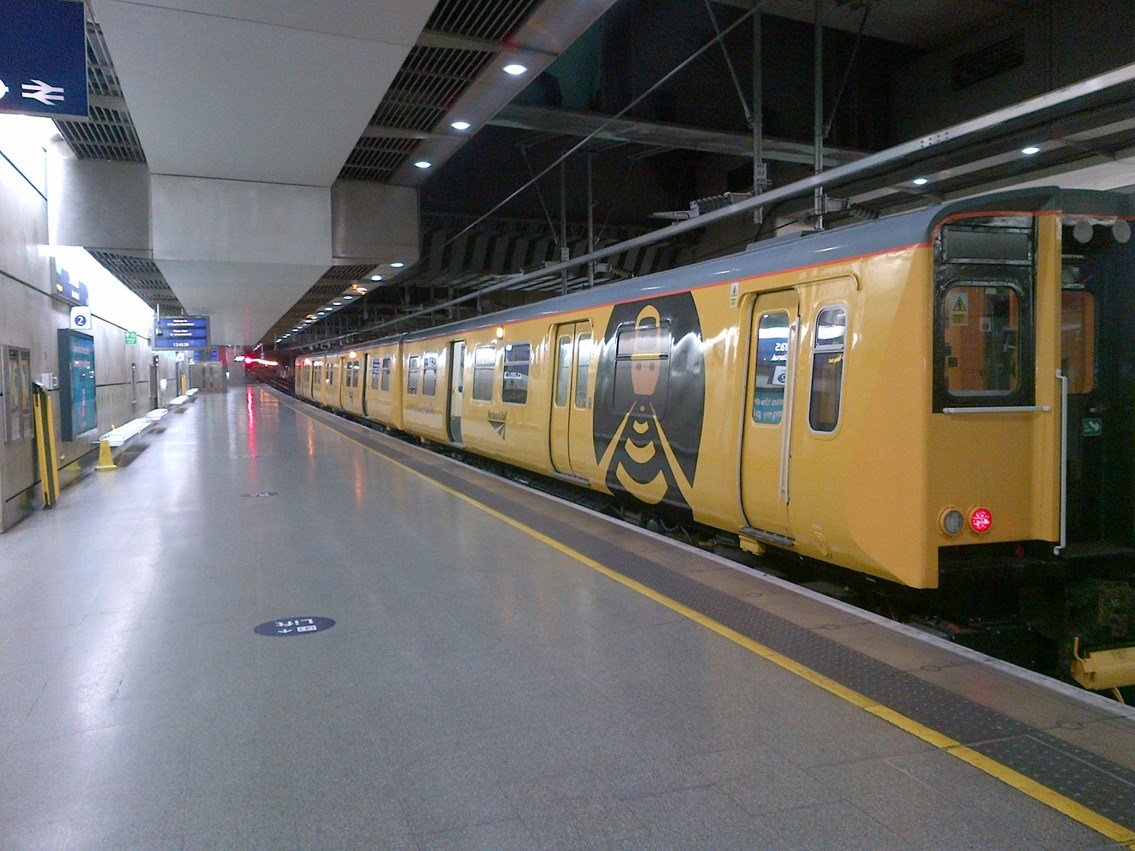Tuesday 15 Dec 2015
Test train runs under cab signalling on Thameslink route through central London
- Region & Route:
- | Southern
A Network Rail test train has run through central London completely under the control of the European Train Control System (ETCS) over two weekends of testing.
This marks the culmination of six years of development work by the Thameslink Programme and the first time a train on the national rail network has run under the cab signalling system in the capital.
The installation of cab signalling is a crucial part of the Thameslink Programme. When it is combined with automatic train operation, it will allow 24 trains per hour to run in each direction between London Blackfriars and London St Pancras International at peak times.
The equipment to allow ETCS operation has been installed on the railway between Elephant and Castle and Kentish Town and the unique Network Rail Class 313 test unit has now successfully made multiple runs under its command.
Paul Bates, project director for the Thameslink Programme said: “These test runs were an important step for the Thameslink Programme and the culmination of six years of work at our test facilities in Hitchin and in our lab at Southwark. It was a credit to everyone who has worked on this project that the equipment worked first time, even on the technically-demanding switchover from traditional signalling to ETCS at Elephant and Castle.”
Keith Wallace, programme director for GTR, said: “This is a significant milestone for the programme and will ultimately lead to a 24 trains per hour service our Class 700 fleet will deliver in 2018.“
The Class 313 was created to test different suppliers’ ETCS equipment on a section of railway north of Hertford, near Watton-at-Stone, and has since spread its wings to visit the Thameslink ‘core’ section. The train ran under ETCS control during a closure of the core to passenger trains – possessions – on the weekends of October 18 and November 1. Signalling was from Three Bridges ROC.
A crucial aspect of the testing was the transition between traditional signalling, and its associated warning systems, and the ETCS controlled central area. In 2018, the new Siemens Class 700s will not only transition between signalling systems but also between manual and automatic train control.
The next step will be the spring visit of the Class 700 to the test track and more intensive testing with the 313. Then in late summer, the Class 700 will begin testing its ETCS equipment between Blackfriars and St Pancras International.
NOTES TO EDITORS
European Train Control System (ETCS) is the train-control element of ERTMS and includes Automatic Train Protection (ATP). ETCS works on the principle of providing to the train a maximum distance that it can travel, the speed profile of the track ahead and other track information about the route that has been set. The train then permits the driver to drive the train, but should the distance or speed limit be exceeded, or be in danger of being exceeded, then the ETCS onboard equipment intervenes to control the train, bringing it to stand if necessary.
The ETCS equipment used on the Thameslink Programme is supplied by Siemens, who are also building the Class 700 trains.
ETCS and automatic train operation will be in place from Elephant and Castle to Kentish Town and also towards London Bridge station
Contact information
Passengers / community members
Network Rail national helpline
03457 11 41 41
Latest travel advice
Please visit National Rail Enquiries
Journalists
Network Rail press office - Chris Denham
Operational Communications Manager
020 3357 7969
07515 626530
chris.denham@networkrail.co.uk
About Network Rail
We own, operate and develop Britain's railway infrastructure; that's 20,000 miles of track, 30,000 bridges, tunnels and viaducts and the thousands of signals, level crossings and stations. We run 20 of the UK's largest stations while all the others, over 2,500, are run by the country's train operating companies.
Usually, there are almost five million journeys made in the UK and over 600 freight trains run on the network. People depend on Britain's railway for their daily commute, to visit friends and loved ones and to get them home safe every day. Our role is to deliver a safe and reliable railway, so we carefully manage and deliver thousands of projects every year that form part of the multi-billion pound Railway Upgrade Plan, to grow and expand the nation's railway network to respond to the tremendous growth and demand the railway has experienced - a doubling of passenger journeys over the past 20 years.
Follow us on Twitter: @networkrail
Visit our online newsroom: www.networkrailmediacentre.co.uk

